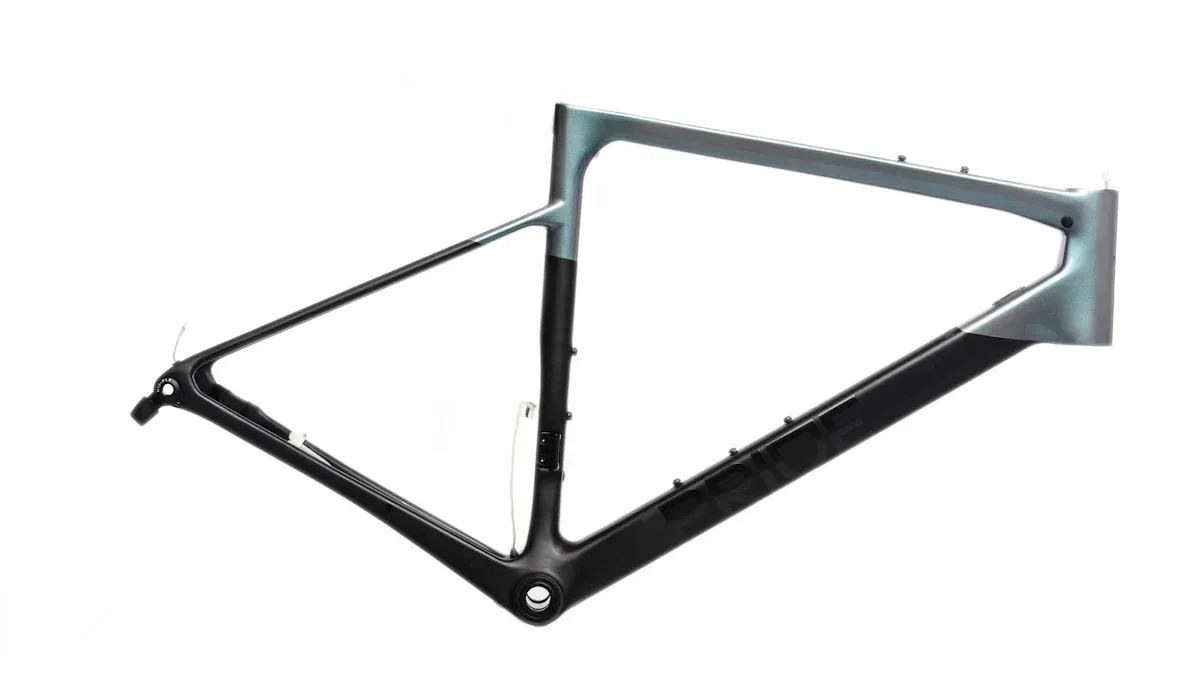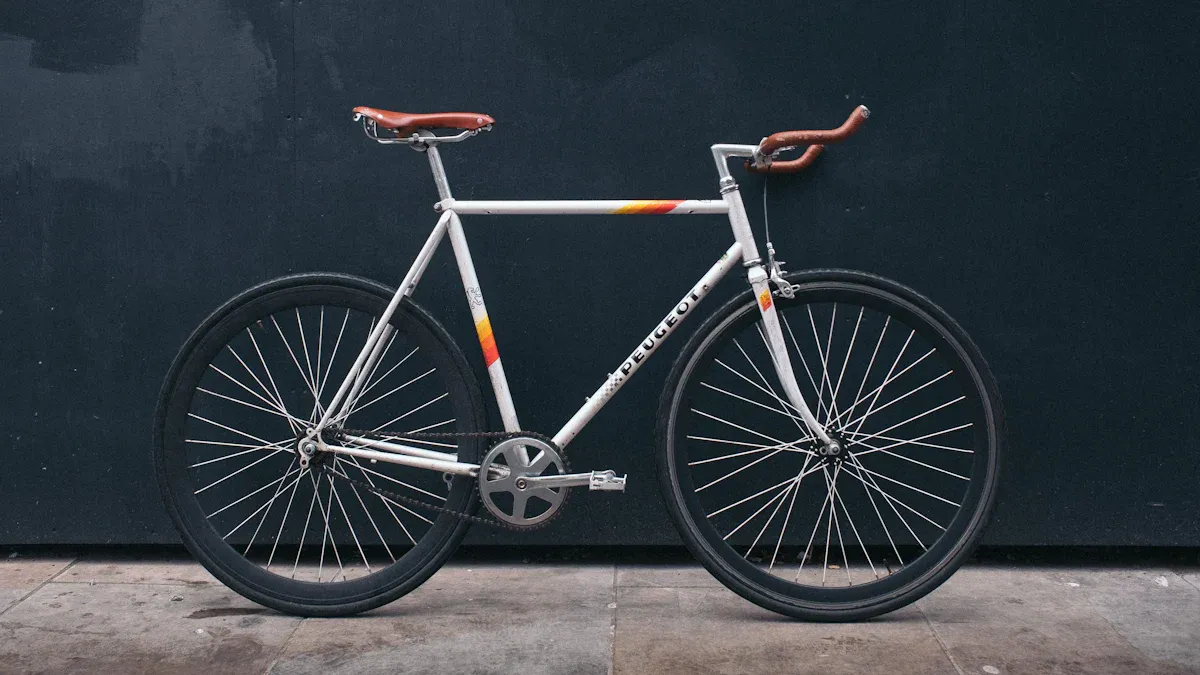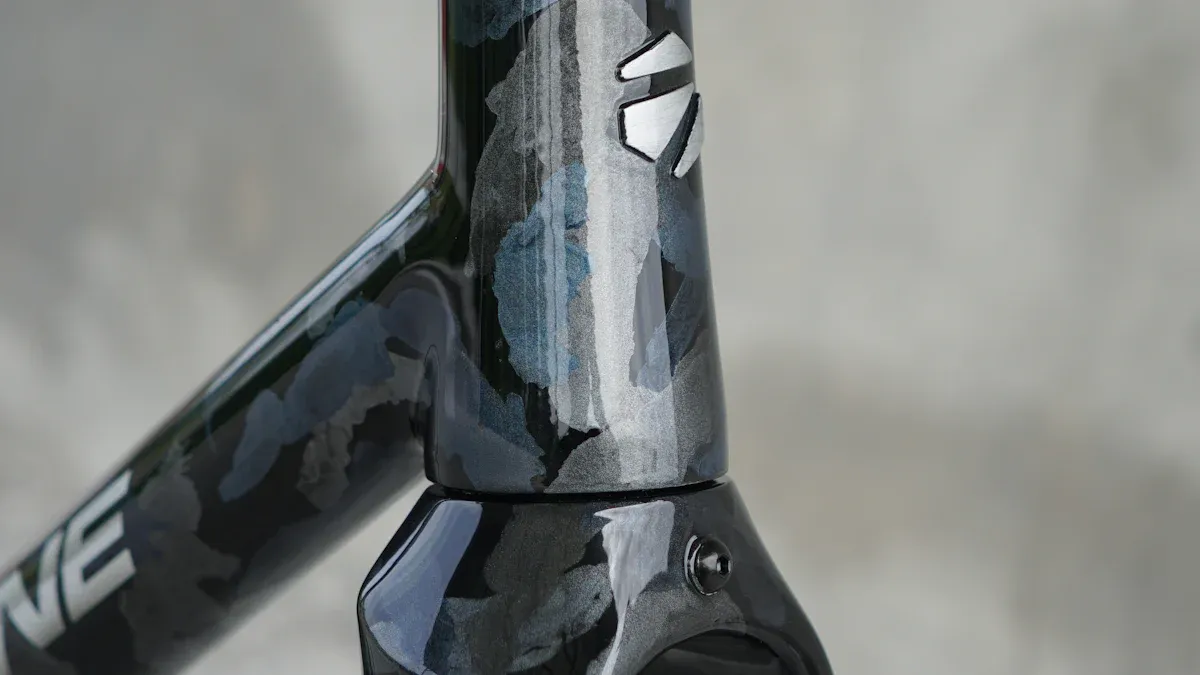
Choosing the right bike frame material is very important for your cycling experience. The material affects your bike’s performance, comfort, and cost. For example, a recent study shows that carbon frames give high performance and comfort but are very expensive. Steel frames offer good comfort at a lower price. An alloy road bike frame provides a good balance between performance and cost. Knowing these differences helps you make a smart choice.
Frame Type | Performance | Comfort | Cost |
|---|---|---|---|
Carbon | High | High | High |
Steel | Moderate | High | Low |
Road Bike Frame Alloy | Moderate | Moderate | Moderate |
Choosing the right frame makes sure you enjoy every ride.
Key Takeaways
Picking the right bike frame material affects how you ride, how comfortable you feel, and how much you spend. Carbon gives great performance but costs a lot. Steel is comfy and cheaper.
Alloy frames, like aluminum, are strong, light, and not too expensive. They are a good choice for riders who want both performance and a good price.
Carbon fiber frames are the lightest and best for racing. They give amazing performance and reduce bumps but cost more and need careful care.
Steel frames last a long time and feel good, making them perfect for long rides. But they are heavier and can rust, so they need regular care.
Think about how you ride, your budget, and the type of ground when picking a frame. Each material has its own benefits, so choose one that works for you.
Alloy Frame Characteristics

Alloy bike frames, especially those made from aluminum, have special features that many cyclists like. Knowing the pros and cons of alloy frames can help you choose if they fit your biking needs.
Advantages of Alloy
Strength and Rigidity: Alloy frames, mainly aluminum ones, are very strong. For example, aluminum 6061 has a tensile strength of about 310 MPa. Aluminum 7005 is even stronger, ranging from 350 to 400 MPa. This strength means the frame stays stiff and can handle different riding conditions without bending or breaking easily.
Lightweight Nature: One great thing about alloy frames is they are light. An aluminum frame usually weighs about 4.6 kg. This makes it lighter than many steel frames. Being lighter can help you perform better, especially when climbing or riding long distances.
Affordability: Alloy frames usually cost less than carbon frames. This lower price makes them a good choice for cyclists who want a mix of performance and cost. You can find good quality alloy frames that work well without spending too much money.
Corrosion Resistance: Aluminum alloys do not rust easily. This is helpful for riders who often ride in wet or humid weather. Unlike steel frames, which need coatings to stop rust, alloy frames stay strong over time.
Disadvantages of Alloy
Ride Quality: Even though alloy frames are strong, they can feel rougher to ride. Compared to steel, which bends more and absorbs vibrations, aluminum sends more road bumps to the rider. This can make longer rides uncomfortable.
Durability Concerns: Alloy frames are strong, but they can wear out faster than steel frames. This means that under tough conditions or heavy use, they might break more easily. It’s important to think about how you ride when checking the durability of an alloy frame.
Limited Lifespan: Aluminum bike frames usually last between 10,000 and 30,000 miles. While this is enough for many casual riders, those who ride a lot may need to replace their frames more often than those made from other materials.
Carbon Fiber Frame Overview
Carbon fiber frames are special in cycling because of their unique features. They are very light and perform well, which makes them popular with serious cyclists. Knowing the good and bad sides of carbon fiber can help you decide if it’s the right choice for your bike.
Advantages of Carbon Fiber
Lightweight: Carbon fiber frames are super light. They usually weigh less than aluminum frames, which weigh about 1500 grams. Being light helps you climb and speed up better, making it easier to go up steep hills.
Performance: Carbon fiber frames are great for performance. They have a strong stiffness-to-weight ratio. This means they send your pedaling power straight to the wheels without wasting energy. This makes your rides faster and better overall.
Vibration Absorption: One great thing about carbon fiber is it absorbs road bumps. This feature gives you a smoother ride and less tiredness on long trips. You can enjoy your ride without feeling every little bump.
Durability: If you take care of them, carbon fiber frames can last a long time. Experts say a good carbon bike can last forever. Benoit Grelier from Scott’s bicycle engineering said, “If done properly, a frame could last you forever.”
Performance Benefit | Description |
|---|---|
Stiffness | A stiffer frame reduces energy loss from flex, making it more efficient. |
Vibration Dampening | Great features absorb road bumps, giving you a smoother ride. |
Aerodynamics | Better aerodynamics help cyclists move through the wind easily. |
Lightweight | Very light but strong, improving climbing and speeding up. |
Efficiency and Power Transfer | Great stiffness makes sure power goes to the wheels, using all your energy for pedaling. |
Disadvantages of Carbon Fiber
Cost: Carbon fiber frames usually cost more than alloy and steel ones. This price can be too high for many cyclists, especially those who need to save money.
Fragility: Carbon fiber is strong, but it can break easier than steel if hit hard. You need to be careful with your bike to avoid cracks or breaks.
Maintenance: Taking care of carbon fiber frames is very important. If you tighten parts too much, it can cause damage. Chuck Texiera said, “The greater hazards are just maintenance, people taking things apart and overcooking clamping.
Steel Frame Durability

Steel frames are known for being strong and comfortable. Many cyclists like these frames because they last a long time. Here are some good and bad points about steel frames that you should think about.
Advantages of Steel
Durability: Steel frames last longer than carbon ones. They can handle a lot of stress without breaking. You can trust steel for long-term use, making it a smart choice.
Comfort: Steel frames give you a smooth ride. They bend a little, which helps soak up road bumps. This makes them comfy for long rides, so you can enjoy your trip without feeling every jolt.
Customizability: Steel lets you create bike designs just for you. You can find or make a frame that fits your needs and likes.
Performance: High-quality steel bikes can perform really well. They can be as fast and easy to handle as other materials, making them good for different riding styles.
Weight Comparison: Steel frames are heavier than alloy and carbon ones. But many cyclists think the extra weight is worth it for the added strength and comfort.
Disadvantages of Steel
Weight: Steel frames are usually heavier than alloy and carbon frames. This extra weight can slow you down, especially in races. If speed is important to you, this could be a problem.
Corrosion: Steel can rust in wet or cold weather. You need to take care of your frame often to stop damage. This upkeep can be a hassle for some cyclists.
Less Stiffness: Steel frames might not be as stiff as carbon ones. This can waste some energy when you pedal, especially in high-speed situations.
Performance Comparison of Bike Frame Materials
When you pick a bike frame, it’s important to know how different materials work. Each material—aluminum, carbon, and steel—has its own good and bad points that can change how you ride. Let’s look at how these bike frame materials perform, focusing on weight, comfort, and cost.
Weight and Comfort Analysis
Weight is very important for how well you cycle. Here’s how each material compares:
Carbon Fiber: Carbon frames are the lightest choice. They usually weigh less than aluminum frames. This makes them great for competitive cyclists. Being light helps with faster starts and climbing hills better.
Aluminum: Aluminum frames are lighter than steel but heavier than carbon. They balance weight and strength well. This makes them good for everyday riders and commuters. However, they might not be as comfy on long rides because they are stiffer.
Steel: Steel frames are usually the heaviest. This extra weight can slow you down. But many cyclists like the comfort of steel. It bends a little, which helps soak up road bumps. This gives a smoother ride over long distances.
Research shows that the material of a bike frame really affects how comfortable a rider feels on long trips. Frames that are stiff side-to-side give stability and send power well. But frames that bend up and down can make riding uncomfortable because bumps hit the rider directly.
Here’s a quick look at how stiff each material is compared to its weight and how long it lasts:
Material | Stiffness-to-Weight Ratio | Fatigue Life |
|---|---|---|
Carbon Fiber | Excellent fatigue resistance | |
Aluminum | Good | Finite fatigue life |
Steel | Moderate | Lower fatigue resistance |
Cost Considerations
Cost is another important thing to think about when choosing a bike frame. Here’s what you should know:
Carbon Fiber: Carbon frames are usually the most expensive. Prices can vary a lot, but you will pay more for the performance they give. This is worth it for serious cyclists who care about speed and efficiency.
Aluminum: Bikes with alloy frames usually cost between $1,249 and $3,299. For example, the Breezer Doppler Team+ costs $1,399.97, while the Cannondale Topstone 2 is priced at $2,000. This lower price makes aluminum a popular choice for casual riders and commuters.
Steel: Steel frames usually cost less than carbon ones. But the price can change based on the quality of the steel and how well it’s made. While you might save money at first, think about the need for maintenance to stop rust.
In competitive cycling, carbon fiber frames are liked by serious riders for being light and efficient. Aluminum frames are known for being strong and affordable, making them good for everyday riders. Steel frames may not be the top choice in races, but they still give a comfy ride for those who want to enjoy long-distance cycling over speed.
Choosing the right bike frame material is very important for your cycling experience. Here are the main things to think about:
Weight: Carbon and aluminum frames are lighter. This helps you ride better. Steel frames are heavier but last longer.
Purpose: If you race, pick a stiff and light frame. If you tour, choose one that lasts for long rides.
Riding Area: Think about your weather. Steel can rust in humid places. Aluminum does not rust as easily.
Time of Use: Steel lasts longer under pressure but rusts faster. Aluminum works well in wet weather.
Budget: Steel frames cost the least, then aluminum. Carbon fiber frames give high performance but cost more.
In short, if you want the best performance, go for carbon fiber. For daily use, aluminum is a great choice. If you want durability and comfort, steel is best. Each material has its good points, so choose based on what you need and how you ride. Happy cycling! 🚴♂️
FAQ
What is the best bike frame material for racing?
For racing, carbon fiber frames are the best choice. They are very light and strong. This helps you use your power well. You can go faster and perform better on the track.
Are alloy frames good for long-distance rides?
Yes, alloy frames work well for long-distance rides. They balance weight and strength nicely. But they might not be as comfy as steel because they are stiffer.
How do steel frames compare in terms of durability?
Steel frames are very durable. They can handle a lot of stress without breaking. If you ride often and want something that lasts, steel is a good option.
Do carbon frames require special maintenance?
Yes, carbon frames need careful care. Don’t tighten parts too much to avoid damage. Check for cracks or wear regularly to keep it safe and lasting.
What should I consider when choosing a bike frame?
Think about your riding style, budget, and comfort needs. Consider the terrain you will ride on and how often you will use the bike. Each material has its pros and cons, so choose wisely!
See Also
Understanding Bike Frame Materials: Carbon, Aluminum, And Steel
Evaluating Carbon Race Bike Frames For The Best Performance
Comparing Enduro Bike Frame Materials For Durability And Strength
